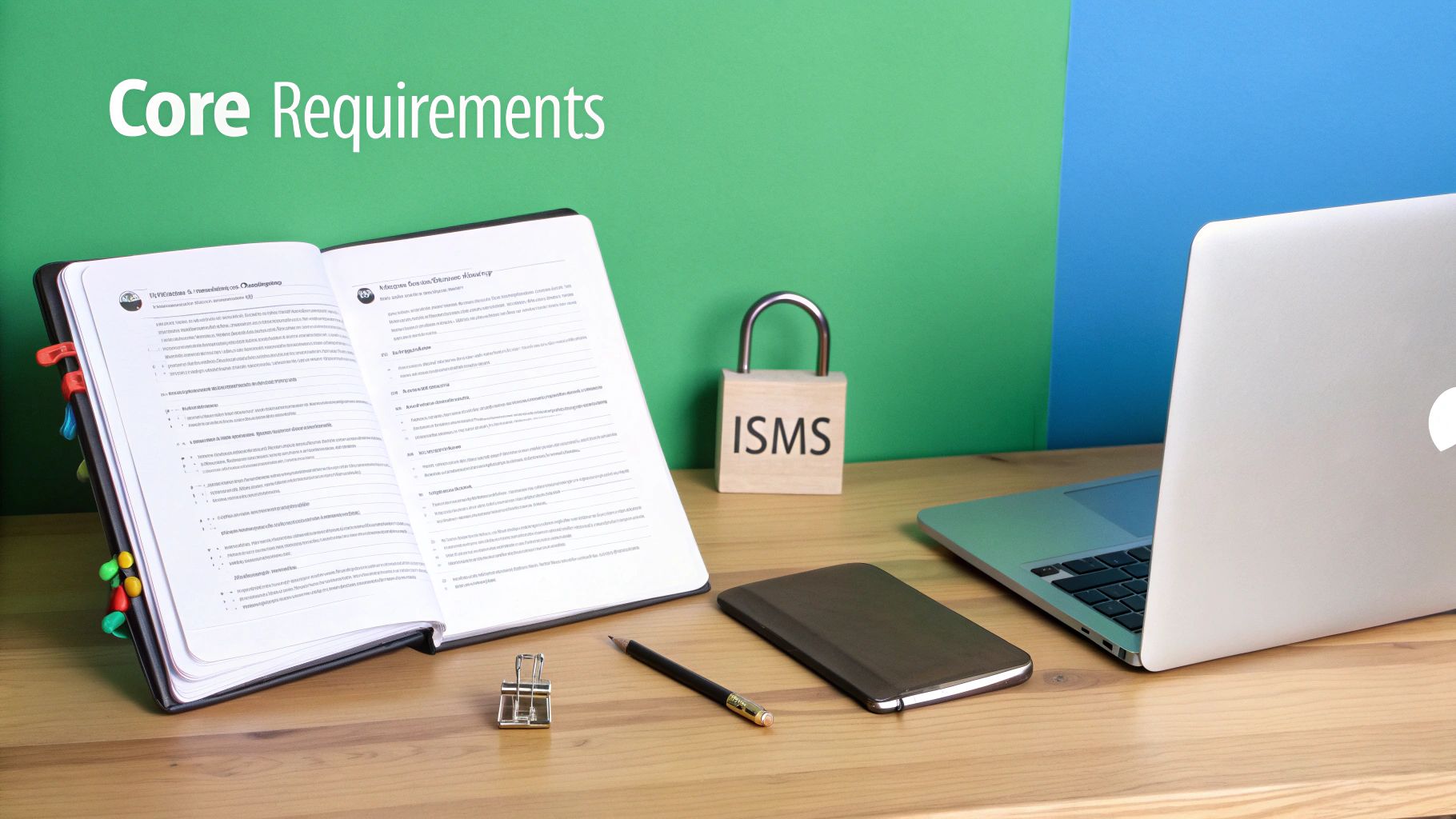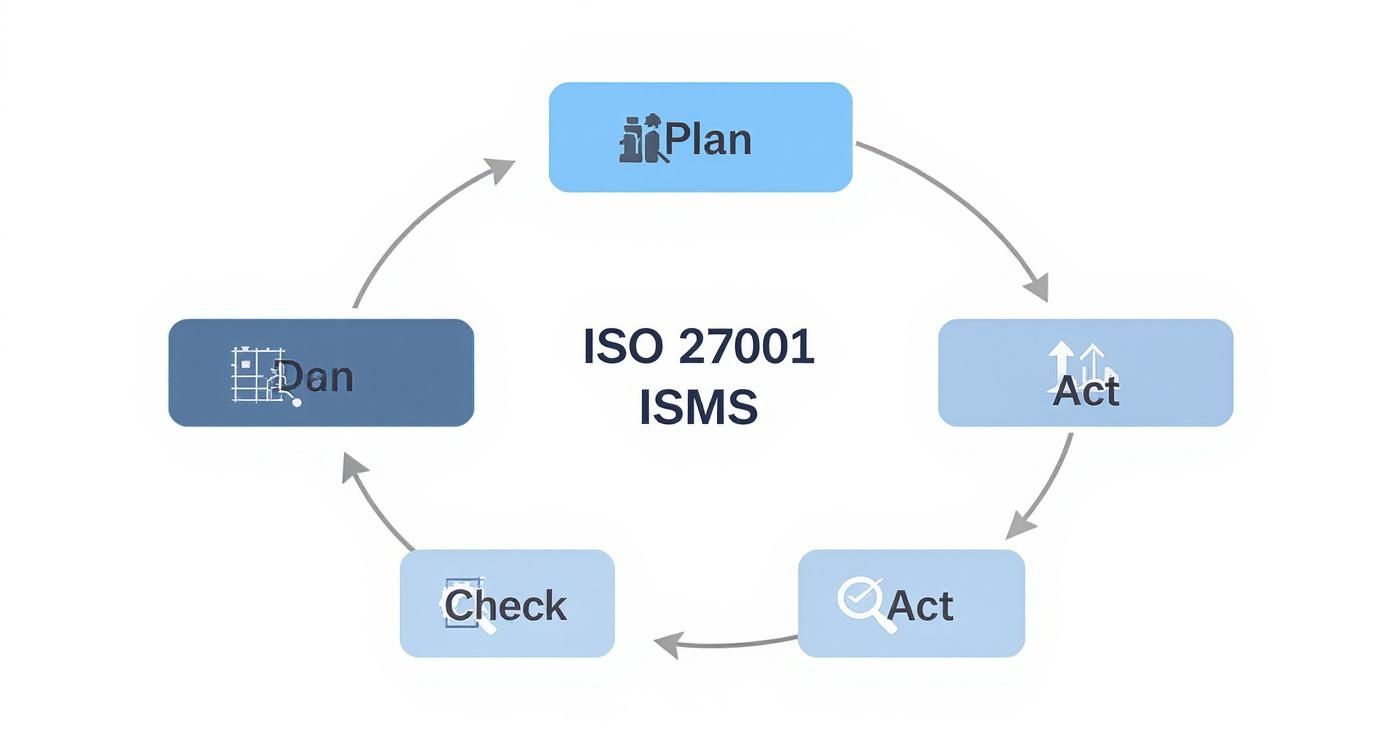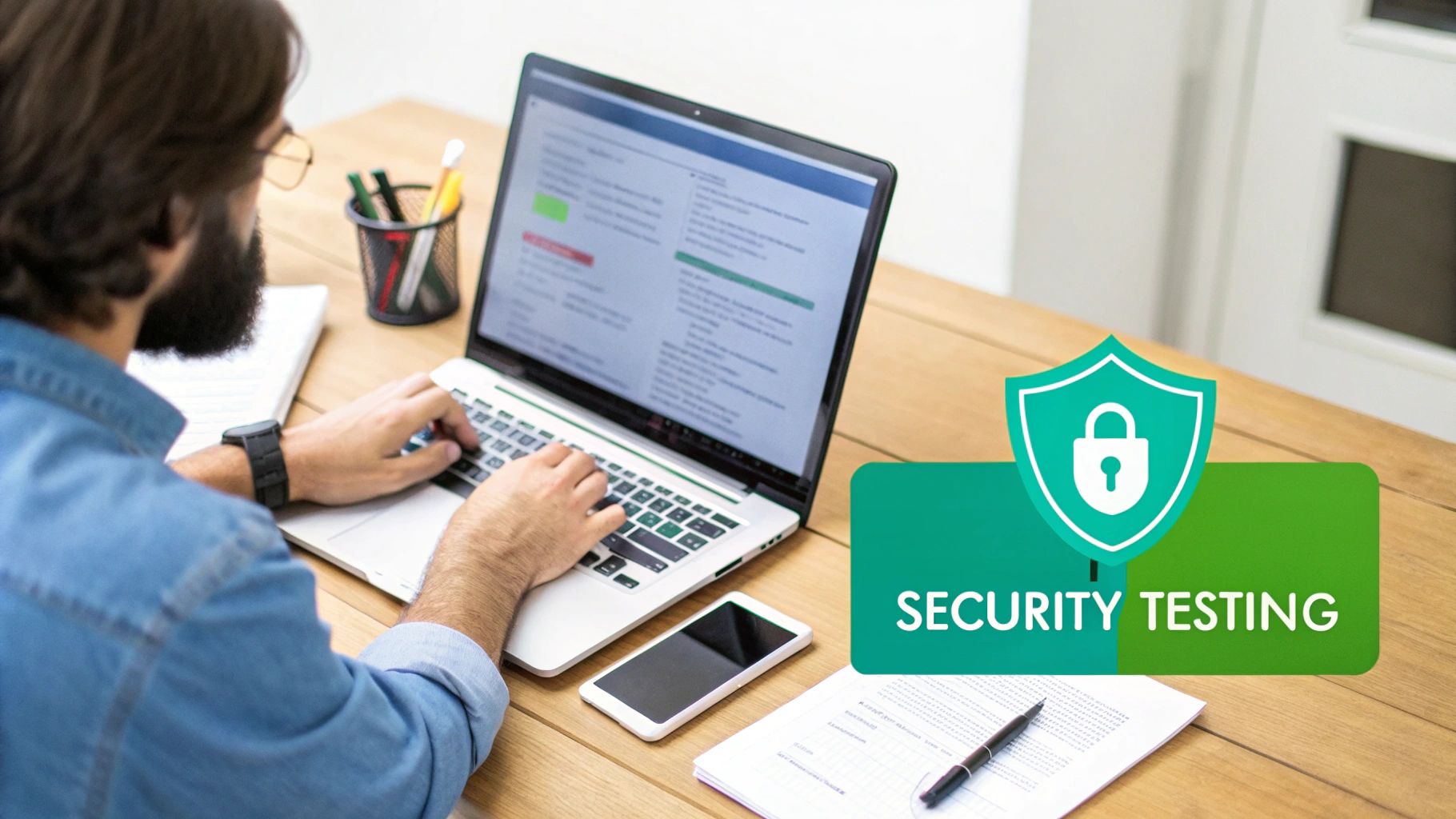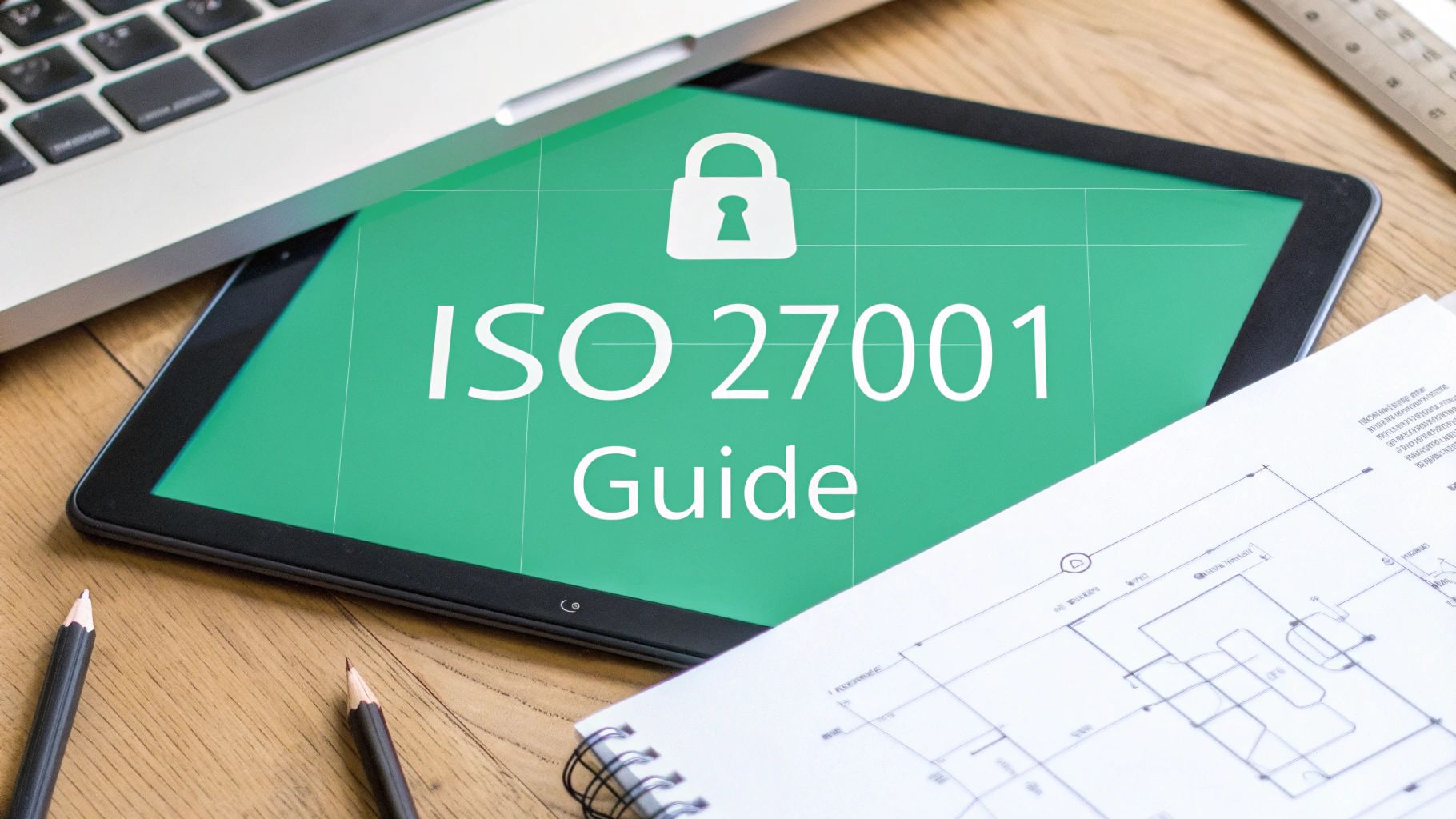Confused by ISO 27001? It’s just a plan to protect your data. Big security firms make it complicated and expensive, but we provide affordable pentesting reports in one week to get you certified faster.
What Are The Core ISO 27001 Requirements?
Getting certified for ISO 27001 isn't about memorizing rules. It's about building a security system that actually fits your company. Think of it as a recipe you can tweak, not a strict legal document.
The goal is to create a security program that adapts to new threats. You figure out what data is important, what could go wrong, and then put smart protections in place. It's a simple cycle of planning, doing, checking, and improving.
Here’s a quick overview of the standard right from the source, the International Organization for Standardization.

The standard has two main parts. The first part is a set of mandatory rules called Clauses 4-10. The second is a list of 93 security options called Annex A controls. You only pick the Annex A controls you actually need.
Many of these controls need proof that they work. This is where penetration testing is essential. Our OSCP, CEH, and CREST certified pentesters provide affordable reports in one week, giving you the evidence you need without the high costs of other firms.
Understanding The Mandatory Management Clauses
Most people focus on the long list of security controls in Annex A. But the real heart of ISO 27001 is the seven mandatory management clauses. They are the rules that tell you how to run your security program.
These clauses, numbered 4 through 10, are your foundation. They guide you from understanding your business to constantly improving your security. Getting these right is what your auditor will check first.
Clause 4 Is Understanding Your Organization
Before you protect your data, you need to know what you’re working with. Clause 4 is about understanding your business and who cares about its security. This means identifying customers, employees, and regulators.
You have to answer simple questions like what kind of data you handle and what your clients expect. This step sets the boundaries for your security system, ensuring you protect what matters. For more information, read about understanding IT governance frameworks.
Clause 5 Is Getting Leadership On Board
Security can't just be an IT problem. Clause 5 requires active involvement from your company's leaders. They must create the security policy and provide the time and money to make it happen.
An auditor will want to see proof that your leadership is truly committed. Without this support from the top, your security program won't succeed. It ensures everyone knows that protecting information is part of their job.
Clause 6 Is Planning Your Risk Assessment
Clause 6 is where the real work of risk management happens. You can't protect against every threat, so you identify the ones most likely to harm your business. This process involves identifying, analyzing, and evaluating risks.
Once you know your biggest threats, you create a plan to handle them. This plan tells you exactly which Annex A security controls you need to use. It’s a smart approach that saves you money by focusing on what's important.
Clause 7 Is Providing The Right Support
A great plan is useless without the right people and resources. Clause 7 is all about support. It covers everything needed to keep your security system running smoothly every day.
This means training your team so they have the right skills and awareness. It also covers communication and keeping clear documents for all your processes. It ensures everyone is on the same page.
Clause 8 Is Running Security Operations
With your plan and support in place, Clause 8 is about doing the work. This is where you put your risk plan into action and implement the Annex A controls you chose. Your daily security tasks live here.
This includes managing user access, performing backups, and responding to security incidents. Clause 8 requires you to have defined processes for these tasks. This ensures they’re done correctly every single time.
Clause 9 Is Checking Your Performance
How do you know if your security is actually working? Clause 9 is for performance evaluation. It requires you to constantly monitor and measure your security controls to see if they are effective.
This happens through internal audits and management reviews. Leadership will review how the security system is performing and decide on improvements. This step gives you the data to make smart security decisions.
Clause 10 Is Always Getting Better
Finally, Clause 10 is about continual improvement. Security threats are always changing, so your protection has to change too. This clause demands that you learn from security incidents, audit findings, or even near-misses.
When something goes wrong, you must have a process to find the cause and fix it. This commitment to improvement is what keeps your certification valid and your organization secure.
How To Navigate The Annex A Security Controls
Annex A is a catalog of 93 security controls that act as your toolkit for protecting your business. Think of it as a menu of options, not a mandatory checklist. You don't have to implement all of them.
The biggest myth about Annex A is that you must apply every single control. You don’t. You only pick the controls that address the specific threats you found in your risk assessment from Clause 6.

As this shows, your Annex A controls are part of a living system that you constantly refine. Your risk assessment tells you exactly which controls to use. This saves a massive amount of time and money.
How Pentesting Validates Your Technical Controls
Implementing technical controls is only half the job. You have to prove they work under pressure. This is where penetration testing becomes essential for your ISO 27001 journey.
Many companies get stuck here. They set up firewalls but can't show an auditor they are configured correctly. A screenshot of your settings is not enough proof for an audit.
Our affordable pentesting service solves this problem. Our OSCP, CEH, and CREST certified pentesters act like real attackers to find vulnerabilities. We deliver a clear, actionable report in just one week.
This report is powerful evidence for your audit, validating key Annex A controls. It’s the fastest, most affordable way to get the proof that will make your auditor happy.
How Penetration Testing Proves Your Controls Work
You’ve set up your security controls, but how do you know they actually work? The answer is penetration testing. It's like hiring an ethical hacker to find weak spots before a real attacker does.
This isn’t just a technical checkup. It's powerful proof for your auditor. Our affordable pentesting gets you a detailed report fast without the high costs of traditional security firms.

How Pentesting Connects To Key Annex A Controls
For ISO 27001, a penetration test is a direct way to satisfy specific Annex A controls. Auditors need real evidence that you are actively testing your defenses, not just hoping they work.
A pentest report proves you comply with key controls like A.5.26 (vulnerability management) and A.8.29 (security testing). Our OSCP, CEH, and CREST certified experts find the vulnerabilities that matter. You get a report in one week.
How To Provide Undeniable Evidence For Your Audit
An auditor's job is to verify everything. When you claim your security is strong, they want to see it in action. A penetration test report provides that independent, third-party validation.
A pentest report shows the auditor you’ve been proactive. It proves you have identified weaknesses and taken steps to fix them. This demonstrates a mature security program, which is exactly what they want to see.
Get An Affordable Way To Strengthen Your ISMS
Let's be honest, "penetration test" sounds expensive. Traditional firms charge high prices and take months to deliver a report. We built our service to be the affordable alternative to get you certified faster.
We focus on what you need: a high-quality, manual pentest that finds real vulnerabilities.
How To Create A Clear Statement Of Applicability
The Statement of Applicability, or SoA, is one of your most critical documents for ISO 27001. It’s a master list of all 93 Annex A controls. For each one, you must state if you are using it and why.
This document proves to an auditor that you've made deliberate, risk-based choices. It shows you've thought deeply about what your business actually needs. It's not just a simple checklist.
How To Link Your Risks To Your Controls
Every decision in your SoA must tie back to your risk assessment. If a control is applicable, you document that you’re implementing it. If it’s not, you must write a clear reason for excluding it.
For example, a fully remote company could reasonably exclude certain physical office security controls. For a deeper dive on this, check out our guide on building a strong cybersecurity risk management framework.
How To Justify Your Security Decisions
Those justifications are everything. This is where you prove to the auditor that you understand your security needs. Vague excuses like "we don't need it" won't be accepted.
A detailed penetration test report is your best friend here. It provides powerful evidence to back up your decisions, especially for technical controls. It makes your SoA instantly more credible and easier to defend.
How To Make Your SoA Audit-Ready
A well-crafted SoA makes your audit much smoother. It builds confidence in your entire security program. A messy SoA is a huge red flag that invites the auditor to dig deeper.
Our OSCP, CEH, and CREST certified pentesters deliver a report in just one week. This report gives you the concrete evidence needed to build a compelling and audit-proof SoA.
Get Certified Faster With Affordable Pentesting
Getting ISO 27001 certified can feel slow and expensive. Traditional security firms charge a fortune and take months to deliver a simple pentest report. This can delay your entire certification.
We are the straightforward, no-nonsense alternative. We are designed to get you the audit evidence you need, fast. We help you meet your ISO 27001 requirements without breaking your budget.
Get Speed and Affordability For Certification
The biggest delay in any certification is waiting. Traditional pentesting firms can take months just to schedule a test and deliver a report. We deliver a comprehensive, manual penetration test report to you within one week.
This efficiency means you can find and fix vulnerabilities right away. Our certified pentesters, holding OSCP, CEH, and CREST credentials, find meaningful weaknesses. To learn more, check the ISO 27001 certification cost breakdown at Rhymetec.com.
Find The Perfect Partner To Meet Requirements
Our service is made for companies that need to check the security testing box and get back to business. We provide the hard evidence you need to satisfy key Annex A controls and pass your audit.
We’re the affordable alternative for a reason. We cut out unnecessary overhead and focus on high-quality manual testing. See how pentesting fits into the bigger picture in our guide on the full ISO 27001 certification process.
Get Common Questions About ISO 27001 Answered
Getting your head around ISO 27001 can bring up a few questions. We see the same ones all the time. Here are clear, straightforward answers to help you focus on securing your business.
Do I Need To Implement All 93 Controls?
Absolutely not. This is the biggest myth about ISO 27001. You only need to review all 93 controls and decide which ones make sense for your specific business risks.
You only implement the controls that are relevant to protecting your organization. This process is captured in your Statement of Applicability (SoA). This risk-based approach saves you time and money.
How Long Does Getting Certified Take?
For most companies, getting certified takes between six and twelve months. This can change depending on your company's size, complexity, and current security practices.
The journey involves a risk assessment, implementing controls, and internal and external audits. Partnering with an efficient service for key steps like penetration testing can seriously speed things up.
Is Penetration Testing Mandatory For ISO 27001?
While the standard doesn't say "penetration testing is mandatory," it is a practical necessity. Several Annex A controls, like A.5.26 and A.8.29, are about finding and fixing security weaknesses.
A penetration test is the most direct and convincing way to prove you are doing this. It provides independent proof that your security controls actually work. Trying to pass an audit without a pentest is an uphill battle.
Ready to prove your controls are effective without the high costs and long waits? Affordable Pentesting delivers comprehensive, audit-ready reports from certified experts in just one week. Fill out our contact form to get started.
.svg)
